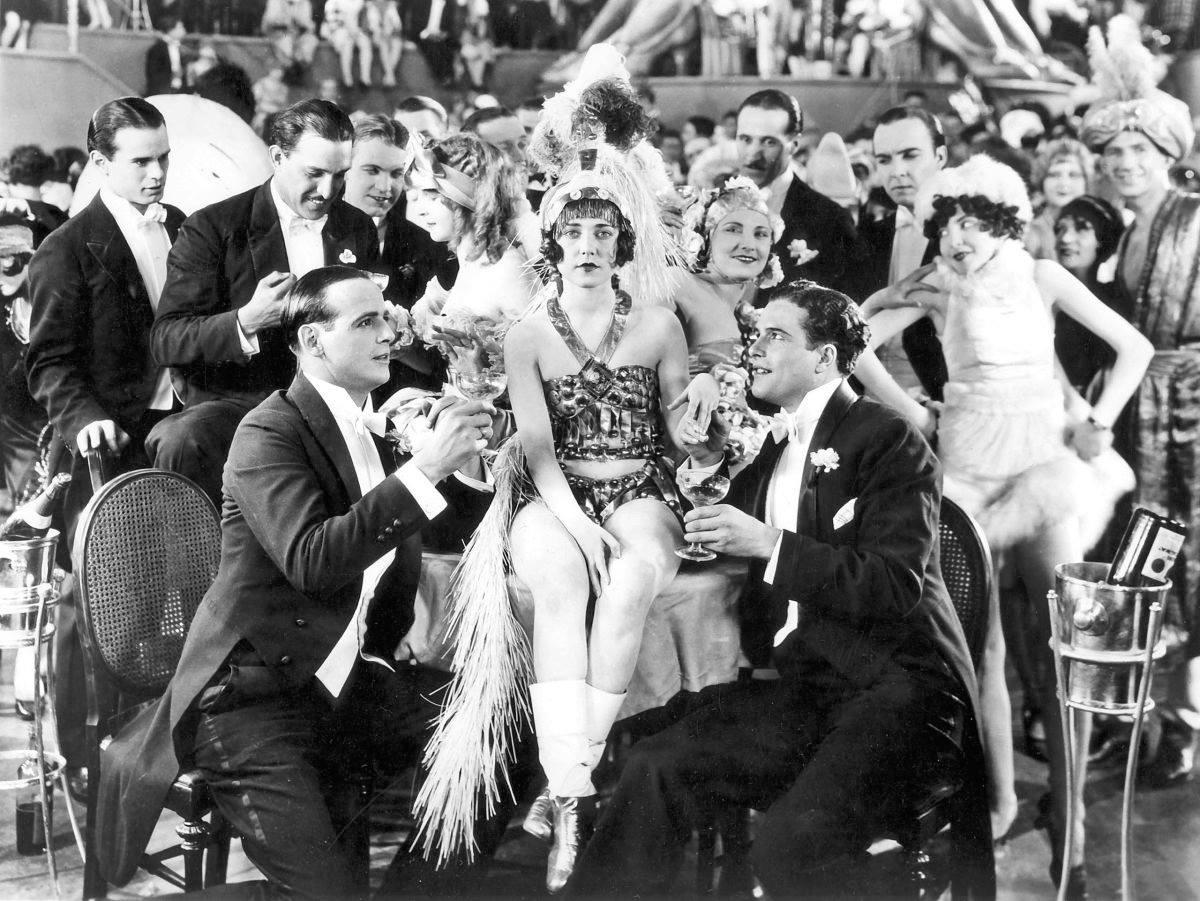MARIANI’S
Virtual
Gourmet
December 26, 2021
NEWSLETTER
IN THIS ISSUE
JAMES BOND'S TASTES, Part Four
LIVE AND LET DIE
By John Mariani
NEW YORK CORNER
SAPPHIRE CUISINES OF INDIA
By John Mariani
CAPONE'S GOLD
CHAPTER 39
By John Mariani
NOTES FROM THE WINE CELLAR
ABADIA RETUERTA'S NEW CUVÉE
By John Mariani
❖❖❖
 On
this week's episode of my WVOX Radio Show
"Almost Golden," on Wed. December 29 at
11AM EST, I will be reading Robert
On
this week's episode of my WVOX Radio Show
"Almost Golden," on Wed. December 29 at
11AM EST, I will be reading Robert  Mariani's
tribute to Mort Fega, jazz emcee legend of
the 1950s, with music by Miles
Davis, Ella Fitzgerald and others.
Go to: WVOX.com.
The episode will also be archived at: almostgolden.
Mariani's
tribute to Mort Fega, jazz emcee legend of
the 1950s, with music by Miles
Davis, Ella Fitzgerald and others.
Go to: WVOX.com.
The episode will also be archived at: almostgolden.❖❖❖
JAMES BOND'S TASTES
Part Four
By John Mariani

Ian Fleming followed up the success of
his first James Bond novel, Casino
Royale (1953), a year later with Live and
Let Die. The movie version, which was
Roger Moore’s first outing as 007, came out in
1973.
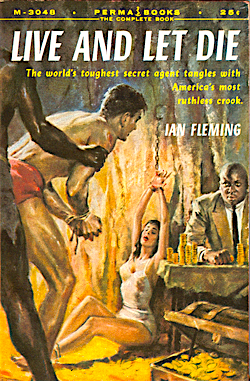 The
novel’s plot involves Bond going after a
Black-American criminal named “Mr. Big” (real name
Buonaparte Ignace Gallia), who is also linked the
USSR’s spy network SMERSH. Big is
smuggling 17th century gold coins to finance
Russian spy operations in the West, so Bond goes
to New York and Harlem, where the coins have been
showing up.
The
novel’s plot involves Bond going after a
Black-American criminal named “Mr. Big” (real name
Buonaparte Ignace Gallia), who is also linked the
USSR’s spy network SMERSH. Big is
smuggling 17th century gold coins to finance
Russian spy operations in the West, so Bond goes
to New York and Harlem, where the coins have been
showing up. 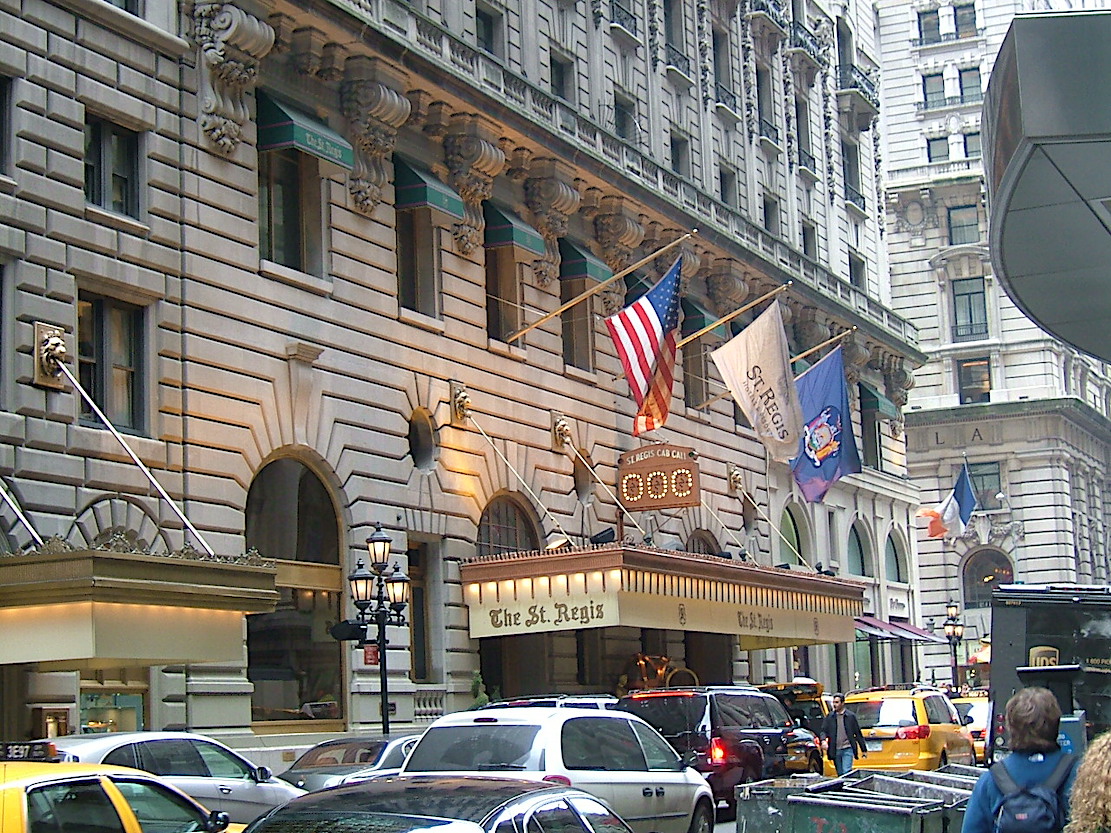
He and CIA agent Felix Leiter are captured
by Big, who employs a beautiful astrologist named
Solitaire to determine if they are telling the
truth. (Leiter later is thrown into a shark tank
and loses an arm and a leg but survives.) Bond
goes on to Jamaica and, while attaching a mine
onto Big’s yacht with Solitaire onboard, is
captured again. Solitaire and Bond are to be
dragged over a coral reef, but the attached bomb
explodes and saves them. Big is thrown in the
water and killed by sharks and barracudas.
Live and Let Die,
the novel, is crammed with food and drink
episodes. In the first chapter Bond is staying at
New York’s St. Regis Hotel, where he has
lunch with Leiter and an FBI man named Dexter,
ordering room service for soft shell crabs with
tartare sauce, hamburgers, French fries, broccoli,
a mixed salad with Thousand Island dressing and
ice cream with melted butterscotch, accompanied by
a bottle of Liebfraumilch “as good as you can get
in America.”
The St. Regis was built by John Jacob Astor
in 1904 (he co-owned the Waldorf-Astoria as well);
one of its luxurious innovations was that each
room had its own telephone. It became famous in
the 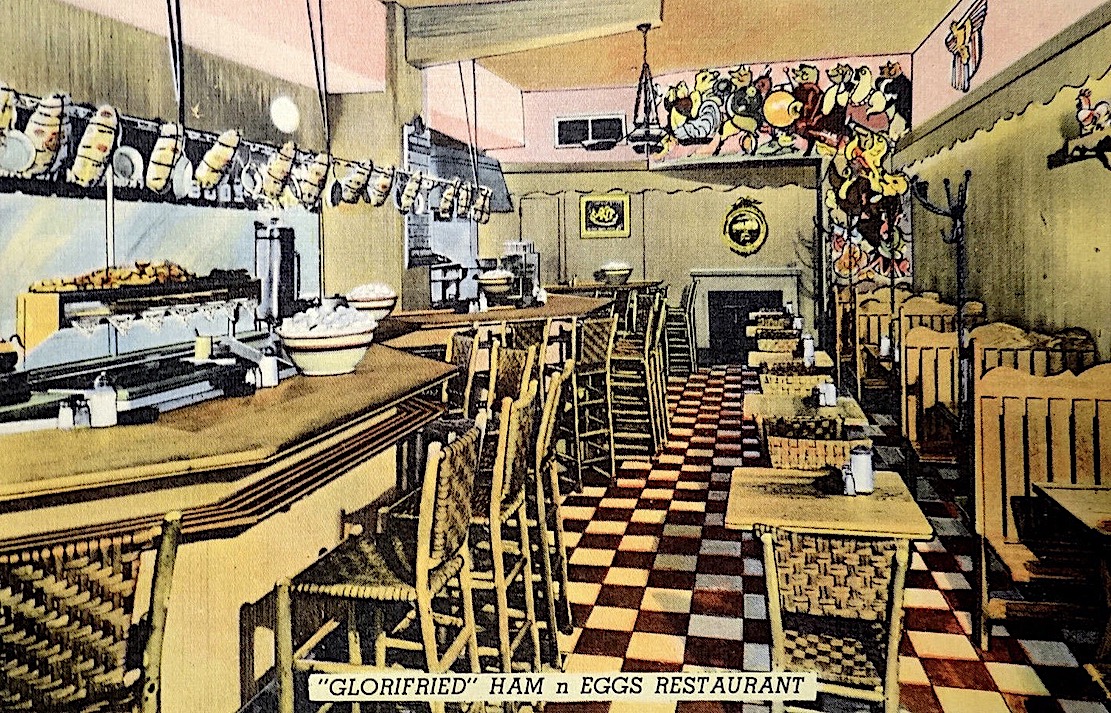 Jazz
Age as the location of the King Cole Bar.
Jazz
Age as the location of the King Cole Bar. 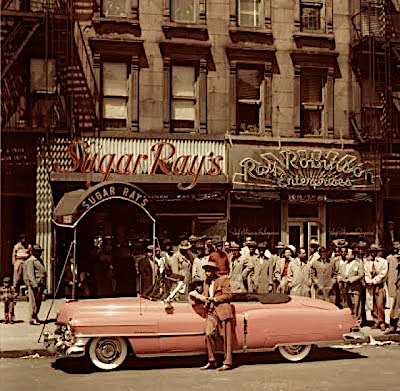
Next day with a room service breakfast of
scrambled eggs and double espresso a bomb arrives
but is discovered, which does not keep 007 from a
lunch on Lexington Avenue at a diner named Glorified
Ham-N-Eggs. For dinner they first stop at Sugar
Ray’s, which really was owned by the boxer
Sugar Ray Robinson, where they have a nip of Haig
and Haig punch bottle Scotch, then on to dinner at
Ma Frazier’s, which was at 2067 Seventh Avenue at
124th Street, which Leiter says is the best
restaurant in Harlem, where they eat Maryland
chicken and littleneck clams.
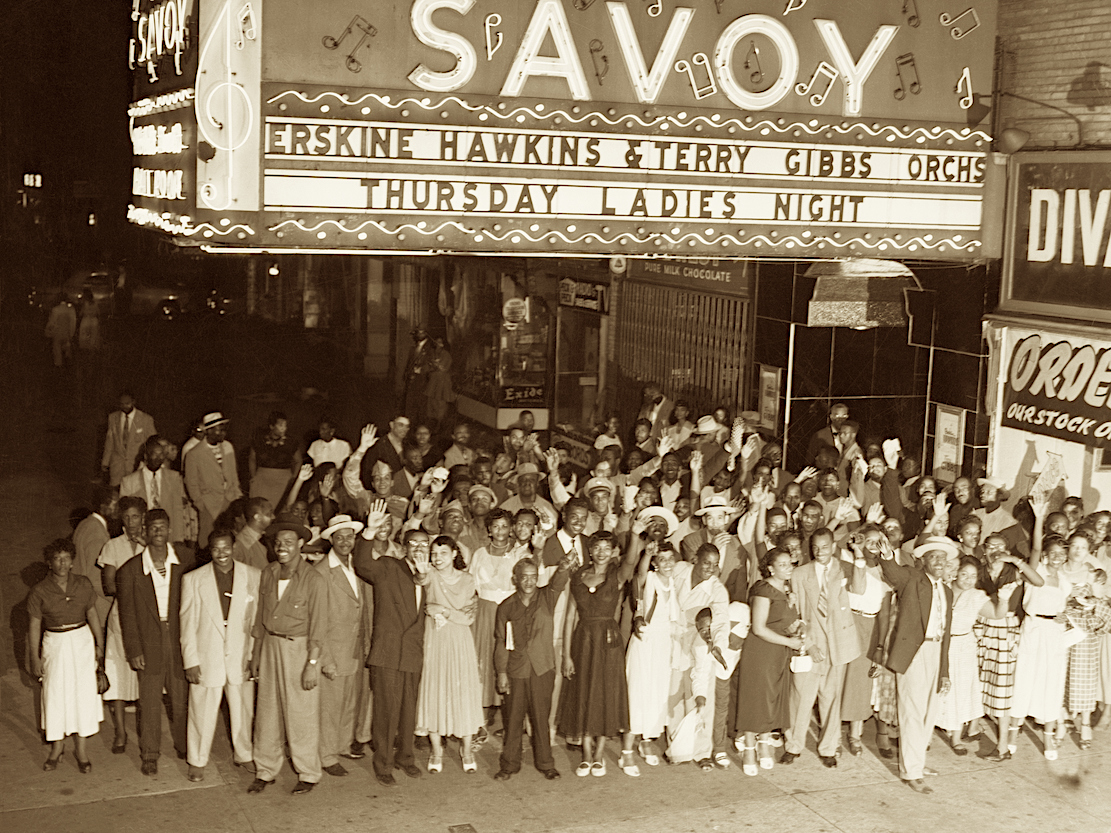 Afterwards they go off to the Savoy
Ballroom (the “Home of Happy Feet”) for
Scotch-and-sodas and to
Afterwards they go off to the Savoy
Ballroom (the “Home of Happy Feet”) for
Scotch-and-sodas and to  watch
the dancing couples. The Savoy was a very popular
club of its day, featuring the big jazz bands of
Duke Ellington and Cab Calloway. It closed in
1958. The two agents finish off the night, or
early morning, with chicken sandwiches at a
fictitious club called the Boneyard.
watch
the dancing couples. The Savoy was a very popular
club of its day, featuring the big jazz bands of
Duke Ellington and Cab Calloway. It closed in
1958. The two agents finish off the night, or
early morning, with chicken sandwiches at a
fictitious club called the Boneyard.
Bond bonds romantically with Solitaire and
escapes from Mr. Big—on the Silver Phantom (actually
“Silver Meteor”) train to Florida, where Bond
observes that its dining car service of Camembert
cheese is “one of the most welcome surprises on 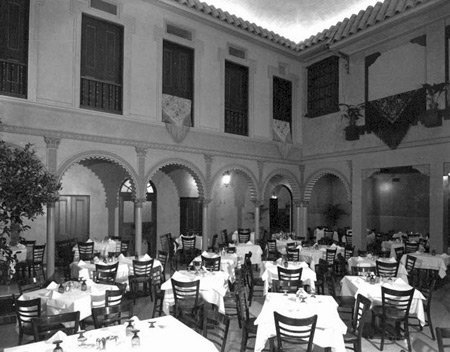 American menus.” The
train ran between New York and Miami, as of 1939
as the first diesel-powered streamliner. Later it
was sold to Amtrak.
American menus.” The
train ran between New York and Miami, as of 1939
as the first diesel-powered streamliner. Later it
was sold to Amtrak.
At their hotel in St. Petersburg Bond
orders a Haig & Haig and Leiter offers to take
them to the Tampa restaurant Los Navidades
(left, 1953), an old Spanish-Cuban food
place that opened in 1890 in Ybor City and was a
hang-out for the Sanchez
y Haya Cigar Factory workers. It closed
in 1972.
At a small grill called Pete’s, Bond orders
“the biggest steak, rare, with French fries he had
ever seen,” with a pint of Old Grandad bourbon. In
Jamaica he relishes the Caribbean food at MI6
agent Commander Strangeway’s home in the Blue
Mountains: paw paw with a slice of green lime, a
dish piled with red bananas, purple star–apples
and tangerines, scrambled eggs and bacon, blue
Mountain coffee—the most delicious in the
world—Jamaican marmalade, almost black, and guava jelly.”
and guava jelly.”
Afterwards, preparing for a strenuous
scuba-diving swim to Big’s island, Bond abstains
from alcohol, and after the conclusion of a
successful mission, he and Solitaire eat a big
breakfast of “the first black crabs of the
season,” roasted suckling pig, avocado salad and
guava with coconut cream, with “the best champagne
in Jamaica.”
 In the film version of Live and Let
Die Bond shows himself as a somewhat prissy
connoisseur, entertaining—and baffling—his
superior “M” with a huge and complicated La
Pavoni Europiccola espresso machine. Otherwise,
there is not much food and drink in the movie. In New
York, Bond takes a
In the film version of Live and Let
Die Bond shows himself as a somewhat prissy
connoisseur, entertaining—and baffling—his
superior “M” with a huge and complicated La
Pavoni Europiccola espresso machine. Otherwise,
there is not much food and drink in the movie. In New
York, Bond takes a
 cab to Harlem
and stops at the Fillet of Soul restaurant
(right) where he asks for bourbon without water, only
to be told that it will cost extra without
water!
cab to Harlem
and stops at the Fillet of Soul restaurant
(right) where he asks for bourbon without water, only
to be told that it will cost extra without
water!
In
Jamaica he checks into the
San Monique hotel (left; then and
now the Sans Souci Resort) and orders Bollinger in
his room and, yet again, later in New Orleans at
the Royal Orleans Hotel, beginning a long
association with that Champagne in Bond films.
There’s another Fillet of Soul restaurant there,
where Bond orders a Sazerac. Aside from a few
other drinks, the film is devoid of any more
meals.
❖❖❖
SAPPHIRE CUISINES OF INDIA
212- 245-4444
By John Mariani

It’s been decades now
that the range and diversity of Indian cuisine
has been rampant in restaurants in Manhattan,
Brooklyn and the Bronx, many within enclaves of
Indian immigrants.
And though there is still a huge audience
for the style of traditional Indian-American
food found at what used to be called curry
houses, Sapphire Cuisines of India’s name is
quite special for its inclusiveness of regional
cooking.
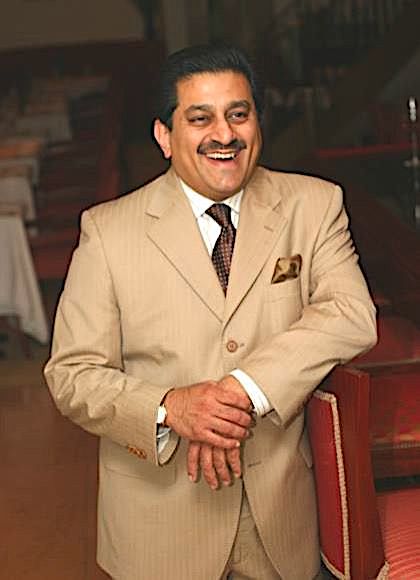 Darshan
R. Shah (left), with partners Satish
Arora and Steve Chopey, originally
opened just at the onset of Covid-19, then
promptly closed. They have relocated to upper
Broadway (near Lincoln Center and the Beacon
Theater), with Executive Chef Sachin
Wagh, of adä, and
sous chef Alpesh Rathod.
Darshan
R. Shah (left), with partners Satish
Arora and Steve Chopey, originally
opened just at the onset of Covid-19, then
promptly closed. They have relocated to upper
Broadway (near Lincoln Center and the Beacon
Theater), with Executive Chef Sachin
Wagh, of adä, and
sous chef Alpesh Rathod.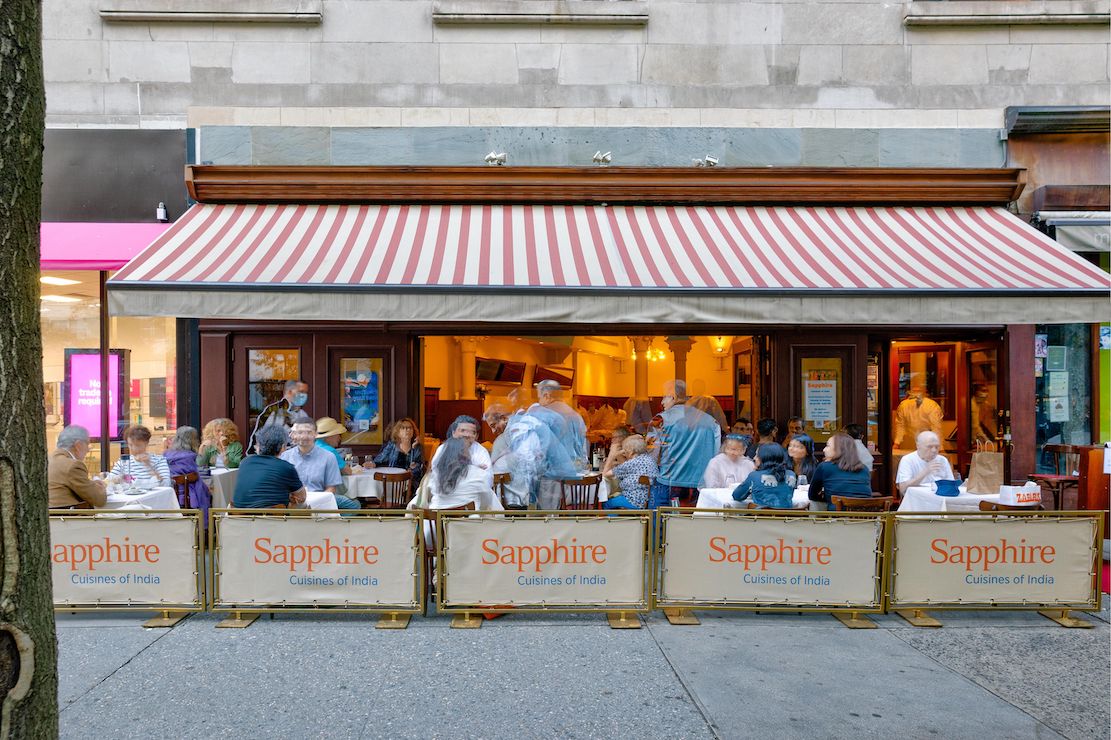
Outside there are tables on Broadway for
warmer weather and inside the ceilings are high
and arched, with banquette and table seating. The
good-looking chandeliers, however, throw too cold
a light that might be modified. A scenic wall
painting by artist Prasanna
Kumar was commissioned from the Fine Art
Studio Table settings are excellent, not least
very thin, fine stemware.
The key to the complexity of flavors
at Sapphire is that the kitchen grinds all its
spices fresh, using none that have been shipped in
that may well have been ground last spring. If you
think of the difference between freshly ground and
bottled cinnamon, you’ll appreciate how different
these flavors can be. As Shah described it, “Each
dish has its special masala
(blend of spices) and each region has specific
spices in its blend, usually based on weather in
that region. For example, in Northern India,
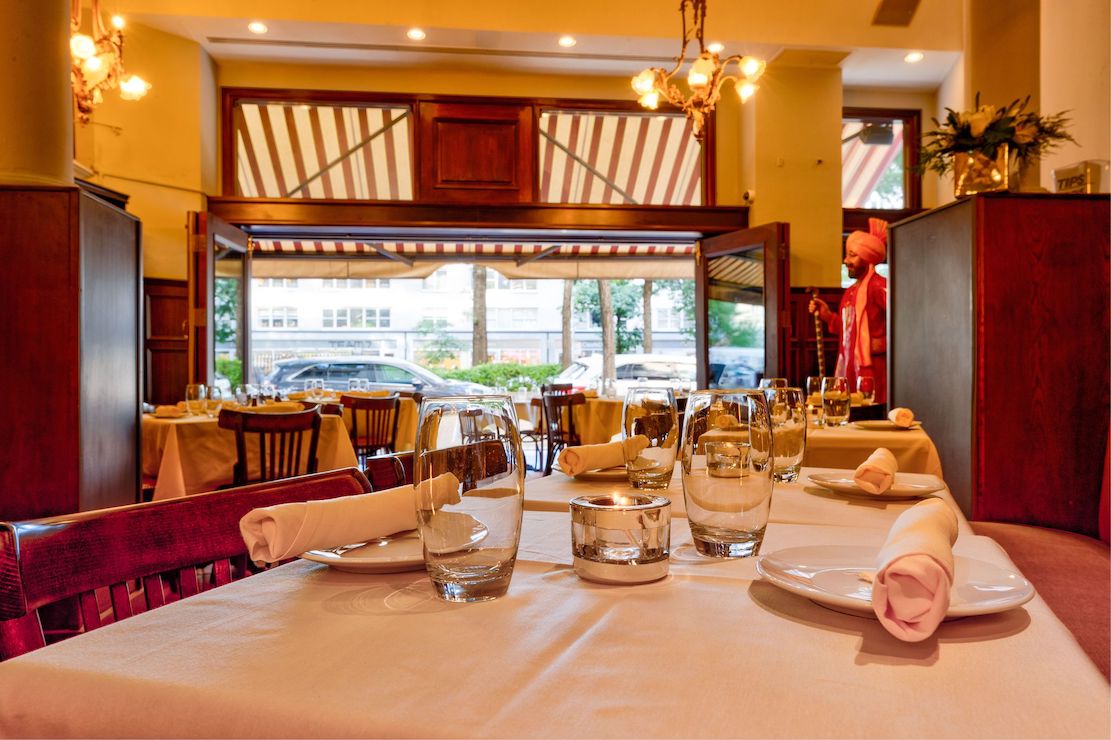 where
there usually is no central heat, many dishes will
have lots of ginger, clover, cardamon, and
cinnamon as these spices warm your body; then they
have yogurt lassi,
which coats the stomach from getting upset. In
Southern India, where it is hot, lots of green
chilies and spices that make you sweat, and in
turn cool your body off."
where
there usually is no central heat, many dishes will
have lots of ginger, clover, cardamon, and
cinnamon as these spices warm your body; then they
have yogurt lassi,
which coats the stomach from getting upset. In
Southern India, where it is hot, lots of green
chilies and spices that make you sweat, and in
turn cool your body off."
The à la carte menu contains many familiar
Indian dishes prepared with those spices, but the
best way to appreciate an array of the newer
interpretations is with the $95 prix fixe menu,
which allows diners to curate their own experience
from an exclusive selection of 15 dishes—four
choices for each savory course and three dessert
choices. We left ourselves in Shah’s hands and
were delighted by what was brought to the table.
A case in point was a lovely dish called
“Vitamin bhel,”
made with millet and other healthful grains like
sorghum to which is added some raw mango and
shredded flour crisps with tamarind sauce. Shah
says that a similar dish made in India is fried,
but this version is not. Dahi kebab,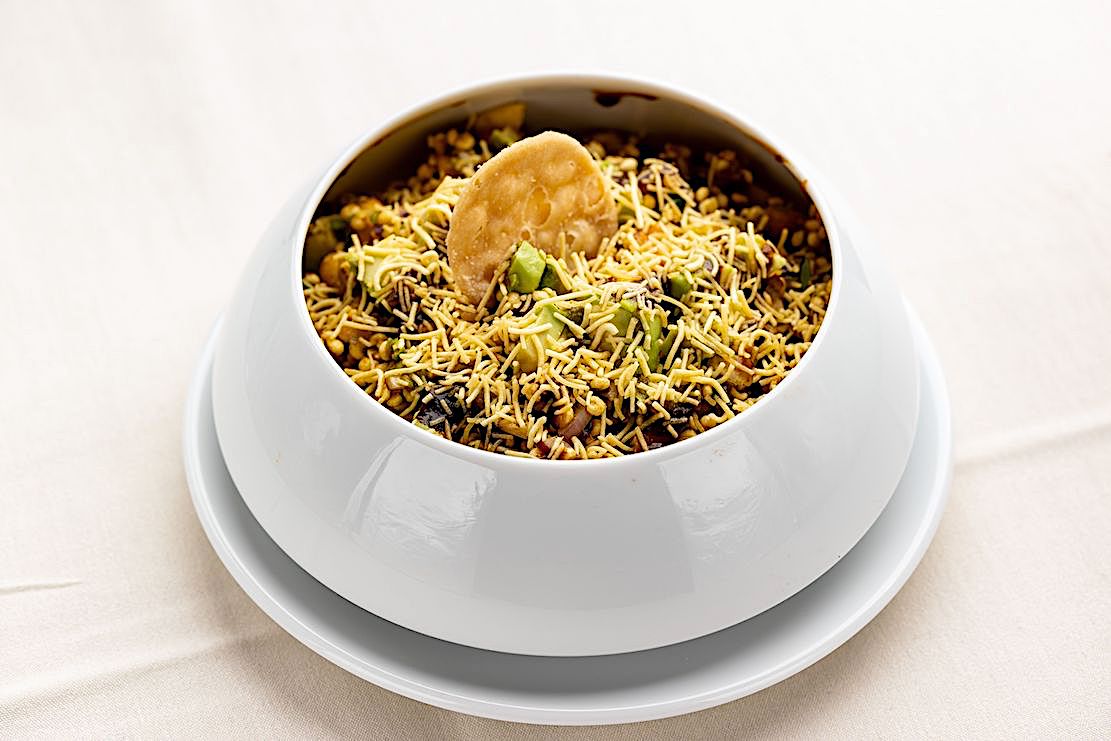 a Northern dish, is a pan-seared strained yogurt
mixed with spices to form a soft cake served over
strips of raw mango slaw with mustard seeds. Morel
mushroom biryani
is made with golden saffron rice laced with
aromatic truffle oil.
a Northern dish, is a pan-seared strained yogurt
mixed with spices to form a soft cake served over
strips of raw mango slaw with mustard seeds. Morel
mushroom biryani
is made with golden saffron rice laced with
aromatic truffle oil.
It’s been a while since I’ve had Chilean
sea bass, because this once over-fished species
began to be raised in farms with poor results. The
specimen at Sapphire was superb, with that very
appealing velvety texture and sweet flavor of the
flesh, here enhanced in a rich, spicy coconut
sauce.
The
tandoori dishes (below) can be had as a
mixed grill, with beef, lamb and chicken all
cooked to their individual degree of
succulence.Pork ribs with a
South Indian spiced marinade is a Goan dish
influenced by the Portuguese taste for vinegared
food like vindaloo.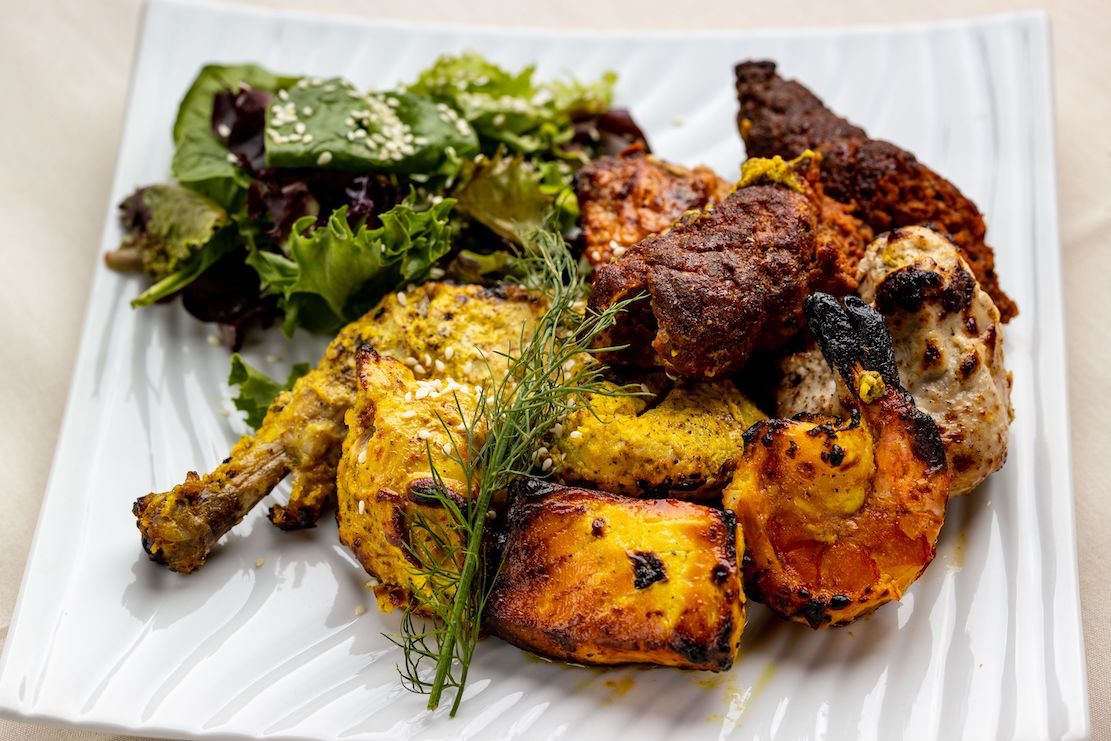 Do not expect charred ribs, for these are well
sauced, served along with masala
truffle fries. Quite unusual was a huge Black
Angus filet mignon cooked as they do in the city
of Lucknow in Uttar Pradesh. It comes with
an abundance of cumin-dusted fingerling potatoes.
Do not expect charred ribs, for these are well
sauced, served along with masala
truffle fries. Quite unusual was a huge Black
Angus filet mignon cooked as they do in the city
of Lucknow in Uttar Pradesh. It comes with
an abundance of cumin-dusted fingerling potatoes.
We tasted a few of the à la carte dishes as
well, including Tandoori-fired chicken tikka in
a creamy tomato sauce with fenugreek
leaves; and some wonderful lentil dal. The
naan
bread came hot, charred, puffy and of the perfect
chewiness.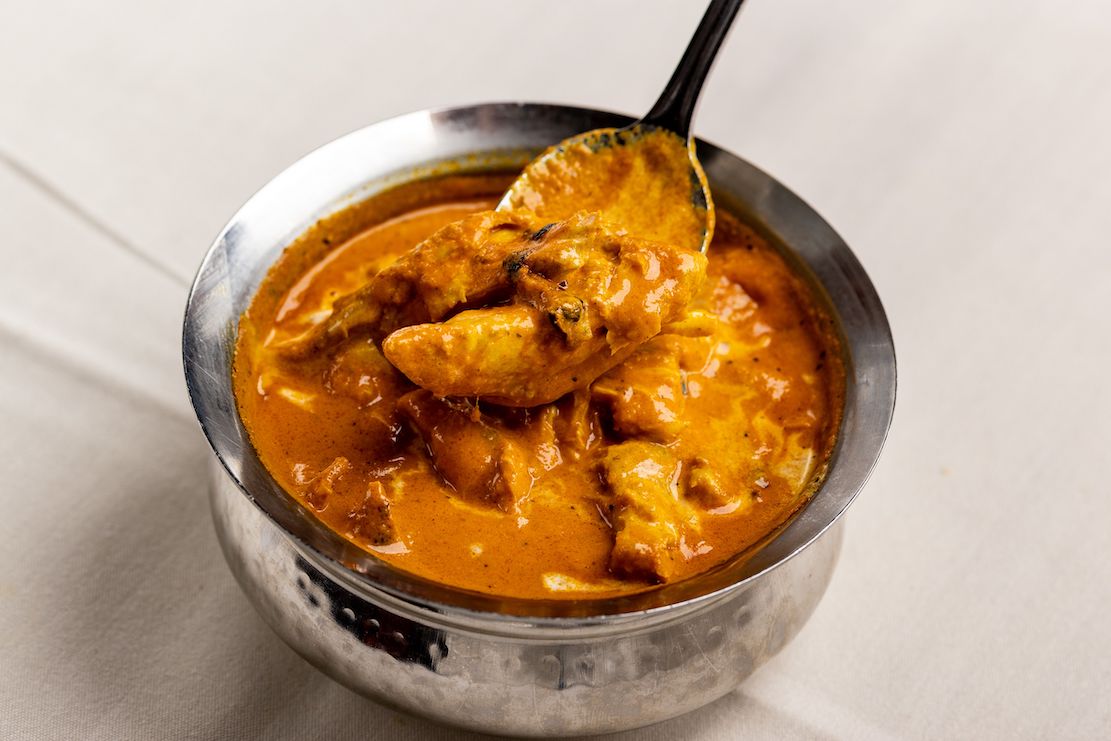
For dessert there was masala chai
kheer (below) with
chocolate dusting, and a
delectable new item called “Malpua and
Rabri,” which are crêpes with reduced
saffron milk sauce then sautéed in ghee butter, and
accompanied by a cookie crumble served with a
blueberry compote.
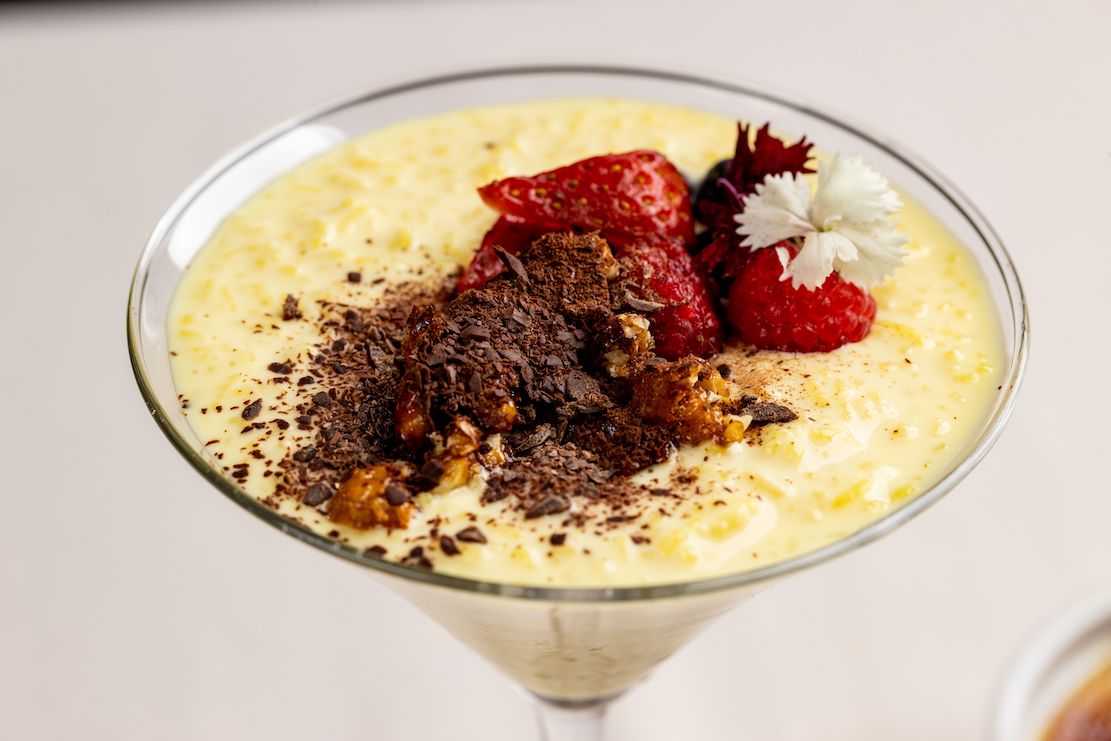 The
wine list is crafted to go with the robust
seasonings of the food at Sapphire, but I
especially enjoyed the imported Flying Horse beer
with Sapphire’s cuisine.
The
wine list is crafted to go with the robust
seasonings of the food at Sapphire, but I
especially enjoyed the imported Flying Horse beer
with Sapphire’s cuisine.
I’ve known
Darshan Shah for many years, though I hadn’t seen
him in a decade. He still exudes both a pride in
what makes Sapphire different and an Old School
hospitality that has him dote on every guest.
Impeccably dressed, he is a host of a kind that’s
getting rarer and rarer at a time when so many
Asian eateries seem to have forgotten good manners
along with what guest ordered what dish.
Open for dinner
Tues.-Sun.
Note: NYC Health Dept. rules require both staff and guests 12 or older to show proof they have received at least one dose of a COVID-19 vaccine.
CAPONE’S
GOLD
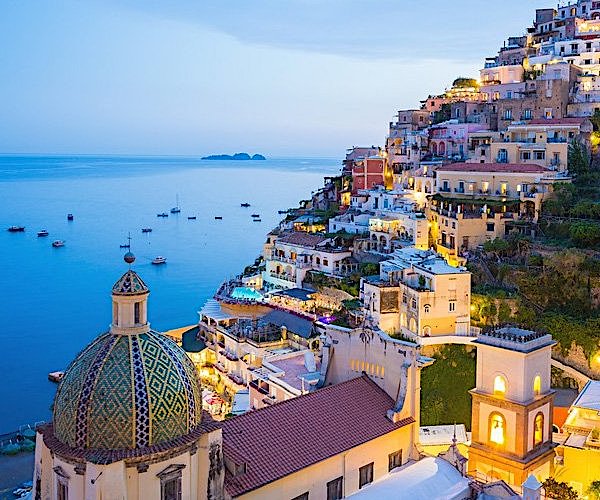
Positano
“Well,”
said Katie as they got into the Fiat. “That
was interesting.”
David
wagged his chin and whistled. “Now that I know
the whole story, I’m more
bewildered than ever.”
“Me,
too. There’s certainly enough to build a story
on. It’s got to be Capone’s
gold. I mean, fifty or more candlesticks and
all the rest of the ornaments and
altar pieces in the church. It adds up to
hundreds of ingots, melted down.”
“And
without a Federal stamp on them,” added David.
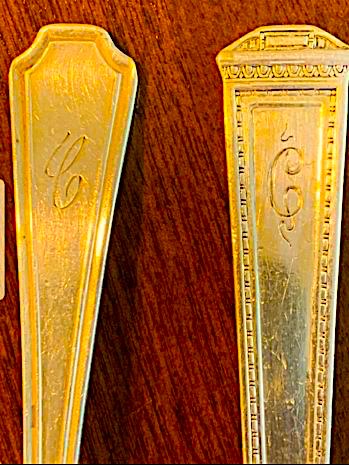 “And,
if
it was Capone’s gift to God in order to save
his immortal soul, it was
certainly in a safe spot. Even if he
eventually told the feds where it was,
they’d have a hard time getting hold of it,
yet he’d have gotten the reward.
But, David, I’m still puzzled as to how he got
the gold over here? Did he put
it on the Italian ocean liners with the rest
of it? Did he have it melted down when
it
got here?”
“And,
if
it was Capone’s gift to God in order to save
his immortal soul, it was
certainly in a safe spot. Even if he
eventually told the feds where it was,
they’d have a hard time getting hold of it,
yet he’d have gotten the reward.
But, David, I’m still puzzled as to how he got
the gold over here? Did he put
it on the Italian ocean liners with the rest
of it? Did he have it melted down when
it
got here?”
“I
don’t think so,” said David. “Remember you
showed me those photos of the Capone
flatware at Theresa Scali’s house? Well,
I
can’t be sure—we can look at the photos when
we get back to Naples
tonight—but they seemed to have the same
patterns as the candlesticks we saw.”
“Meaning
they were probably made by the same
fabricator?”
“Right,
an American company. So, if Capone used just a
few ingots to make his own
personal dining set, he must have melted the
rest down, had them made into
candlesticks and church implements, then
silver plated.”
“And
how would he get them to Angri?”
“It
all makes sense this way,” said David. “After
the disaster with the rumrunner
and U-boat, the arrangement for another third
of the gold to be shipped to
Italy on the ocean liners was easy enough to
arrange through Mussolini. His
people, along with Capone’s friends on the
docks, would allow the gold to go
onboard, no questions asked.”
“Okay,
I follow so far,” said Katie.
“But
there was still a third of the gold Capone
held, and he wanted to hedge his
bets in case Mussolini double-crossed him, or
the Germans got the gold. He
probably never knew that Vito Genovese had
arranged with the American Army and
the feds to transfer as much of the gold as
they could back to the States. So
Al still had hundreds of ingots melted
down into candlesticks and the rest and had
them silver plated. That way he
could have shipped them across the Atlantic on
any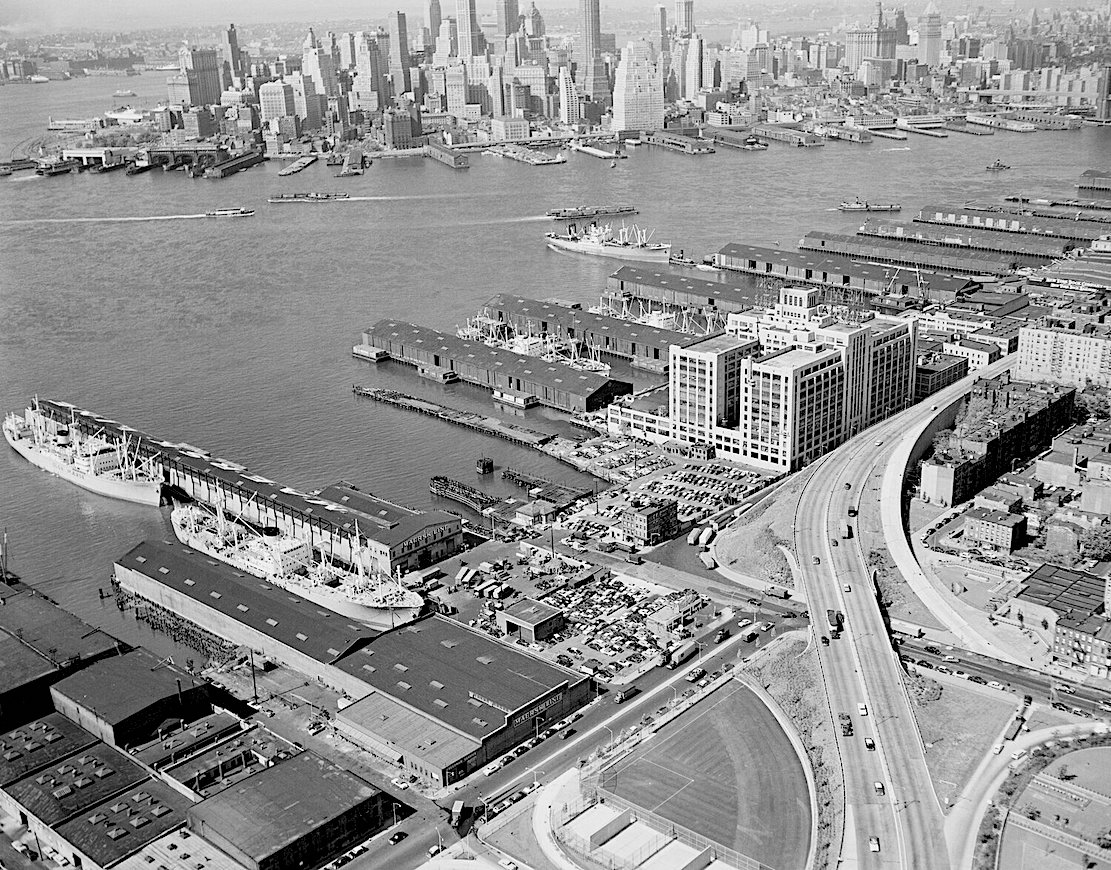 ship
he wanted. They might
have been heavy, but, if silver candlesticks
are listed on the ships’ manifest,
it’s not going to raise much suspicion,
especially if Capone’s friends on the
Brooklyn docks (right) in New York
oversaw the loading of the boat.”
ship
he wanted. They might
have been heavy, but, if silver candlesticks
are listed on the ships’ manifest,
it’s not going to raise much suspicion,
especially if Capone’s friends on the
Brooklyn docks (right) in New York
oversaw the loading of the boat.”
“Greco,
you are a helluva detective,” said Katie.
“That is an amazing story. Capone
keeps some gold hidden in reserve to
help get him into heaven and even when the war
breaks out, he knows the Church
will hide it all somewhere, as they would any
treasured objects. What
a great scheme.”
“I
think we got lucky there at the end,” said
David, “but it’s the only way the
whole thing hangs together. Three stashes of
gold. One
lost. One in Mussolini’s custody. One
hidden away in his mother’s church, where
nobody except a succession of parish priests
knows the truth.”
“Very
. . . very well played,” said Katie.
“Too bad Al’s brain started to rot out
before he had any chance of
getting his revenge.”
“Hey,
who knows? Maybe Al is now up in heaven with
his mother and father and the rest
of his family.
I wouldn’t put it past
him to bribe his way in with St. Peter.
If I remember correctly, those angels
play harps of gold.”
Katie
stretched her arm out the window of the Fiat
and asked, “Well, Detective Greco,
you think we should reward ourselves with a
day trip to Capri?”
David
was all for that idea but suggested they drive
down the coast a bit more—they
had the rest of the afternoon—and visit
Positano, Amalfi, maybe Ravello, and
stay over till the next day.
“Drive
on, maestro!” Katie said.
*
*
*
*
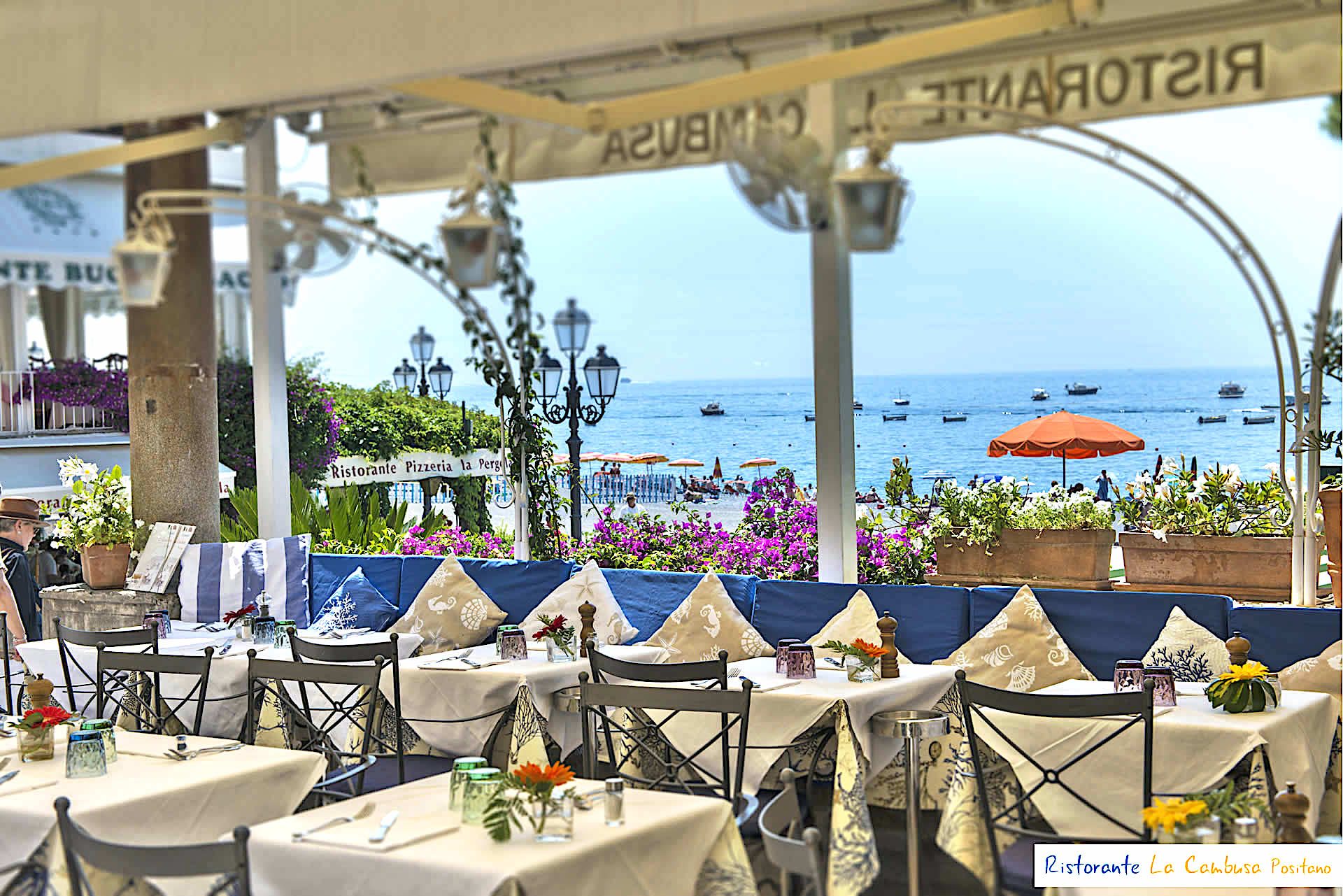 Feeling
as if they’d already collected a reward—the
simple fact of solving the mystery
of Capone’s gold—gave the afternoon the
refreshing feeling of having a weight
off their shoulders. They
took their
time driving down the Amalfi Coast on what had
turned out to be a brilliant
autumn day, with a brisk breeze coming off the
sea.
Feeling
as if they’d already collected a reward—the
simple fact of solving the mystery
of Capone’s gold—gave the afternoon the
refreshing feeling of having a weight
off their shoulders. They
took their
time driving down the Amalfi Coast on what had
turned out to be a brilliant
autumn day, with a brisk breeze coming off the
sea.
Following
the signs for Positano, they began the
serpentine crawl down the side of the
mountain to a town that seemed barely attached
to the rocks. Its buildings,
some owned by very wealthy Italians and,
increasingly, Russians, were done in a
riot of bright pastel colors, the streets
lined with lemon trees and bushes of
basil, thyme and rosemary.
The
tourist crush of spring and summer had mostly
subsided, but parking anywhere
was difficult, so, when they did find a space,
they ate at the nearest
trattoria, La Cambusa on the Piazza Vespucci,
with a breathtaking view of the
water. They feasted on whatever the owner
suggested, which was what was brought
in by the fishermen down at the town dock that
day.
“Let’s
not talk about Al Capone today,” said Katie.
But, after a glass of wine, they
couldn’t help themselves.
“So once they know the whereabouts, you
think the feds will come round
up the gold?” she asked first.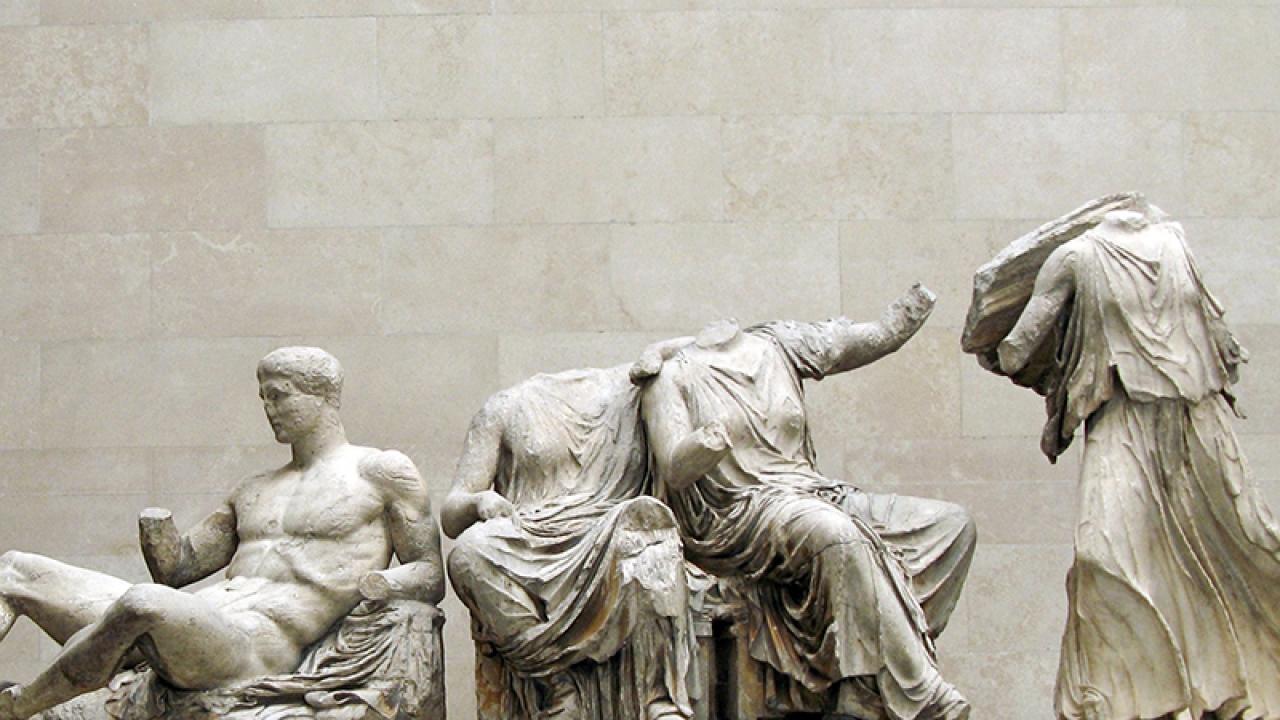
“Ha! Not likely. They would have to
jump through so many legal
hoops—international banking, the gold market,
Interpol, the Italian government and
the Naples police, not to mention the Vatican
and the townspeople of Angri.
Like the Monsignor said, it would be tough to
get the town to give up their
religious artwork going back seven decades.”
“Even though the Fed had ownership?
It’s not like they’re the Elgin
Marbles,” said Katie.
“Whose marbles?”
Katie suppressed a chuckle, saying,
“Lord Elgin was a Brit who gathered
up all the marble statues that had fallen off
the frieze of the Parthenon in
Athens, then he shipped them back to London
and the government had them
installed ‘for safekeeping’ in the British
Museum. The
Greeks have been trying to get them back
for close to two centuries now.”
“Oh, and you think the Italians are
going to wrap up the gold in San
Giovanni and just ship it all back to the
U.S.?” asked David. “Believe me, even
before litigation started, the Camorra would
find a way to get it all out of
the church.”
“Wouldn’t the Neapolitan police keep
that from happening, once this
became known in the news?”
“You mean, your article in McClure’s?”
David shook his head and laughed. “You
don’t know the Neapolitan police.
Primerano and Lucadamo were two exceptions,
real professionals, but most of
them are inept at best. You might as well put
the Pope’s Swiss Guard inside the
church. Which, now that I think of it, is not
a bad idea.”
“But what would the Camorra do with
gold that would become so famous
they couldn’t use it?”
“I
don’t know. They might make a present of it to
the Vatican and replace the
candlesticks and ornaments with replicas. Then
the Vatican could keep it secure
in its own vaults.”
“And the Camorra would get . . . what?”
“Access to Vatican bigwigs. The
grateful thanks of God Almighty. I
really don’t know. In any case, the secret
will be out and now the whole world will have
to deal with it.”
Katie turned strangely quiet.
“More wine?” asked David.
Katie shook her head and just looked
out to the sea.
“All right, what’s the matter, Cavuto?”
Katie put her chin in her hand and
said, “It’s so very beautiful here.
And it’s been this way for such a long time.”
 “Well, except for that little patch of
inconvenience called World War
II.”
“Well, except for that little patch of
inconvenience called World War
II.”
“I
mean how it all goes way, way back, with a
succession of invaders and kings and
princes who tried to rob the people in
Southern Italy of whatever wealth it
had. And
how it was so bad for so many
people that they left this gorgeous place and
sailed to an unknown land called
America.
“You can see how little towns like
Angri a hundred years ago would have
lost maybe the majority of its people,
including Teresina Raiola (left). They
had next to nothing, and it’s still
pretty poor down here in the south. They’ve
got plenty of crime and lots of
corruption, and people still take advantage of
them. All they can cling to is
the Church and their little parishes where
they were baptized, like their
fathers and mothers and grandparents and
great-grandparents were—at least those
who didn’t move to America.”
“And become gangsters, like Al Capone,”
quipped David.
“That’s not fair, David. Your ancestors
didn’t, mine didn’t, and we
didn’t. Capone wasn’t even born here and his
only connection to the region was
through his long-suffering mother.”
“I
know. You’re right,” David said. “Capone and
all the hoods I went after helped
blacken all the Italian immigrants who left
here. Looking
around, it must have been very
difficult for them to pick up and go.”
David hoped Katie might start singing
“Return to Sorrento” again, but
she seemed glum.
“You know what I’m thinking, David?”
“I
. . . have a feeling I do.”
"I
was thinking, what if I didn’t write the whole
story after all?
What if the gold of Angri was never
found,
not even by the people of Angri. The
feds haven’t a clue as to the gold’s
whereabouts and it sounds like the Camorra
doesn’t either.
What if we just kept the
secret of Angri?”
David’s mind was churning under the
influence of two more glasses of
wine than Katie had.
“After all we’ve been through,
including almost getting murdered and
made into fish food? Not to mention the money
we spent on the whole
project.
And I’m not even thinking of
the reward money.”
“Okay, what if we use what we’ve got on
two-thirds of the gold—the
sunken treasure in the Caribbean and the
secret transfer to the Fed by Genovese
and his friends in the U.S. Army. Then we have
the attempted murder interlude
by a Mafia thug.
That makes for a
helluva good story, and it will really piss
off your pal Frank English.”
“That alone makes it sound enticing,”
said David. “So, let me get this
straight: You turn in all your notes and
recordings and a nice fat story about
the two-thirds of the gold we’ve found.”
“Yes, and we can corroborate all of it.
The Angri gold, we really can’t,
and by so doing save that little town and its
people a whole lot of publicity,
misery, court costs, and so on. I’m positive
my editor will go for that; I’ll
get paid, you’ll get paid.”
“But no reward?”
Katie put her hand around David’s
shoulder.
“Detective Greco, what was the reward
you got
from putting guys like Gotti away?”
“I
felt like a million bucks.”
“Well, there you go. You’re
going
to get a nice big fee for helping me on the
story and the knowledge you figured
out a mystery no one else could for more than
fifty years. And, you got to hang
out with me on the Amalfi Coast! That
enough?”
Then Katie gave him a big kiss on the
cheek.
“That and that kiss makes it enough,”
said David, kissing her on both
cheeks. “I love you, Katie.”
“Me, too,” she said, but
both of them knew it was really out of mutual
respect and nothing more romantic than that.
At least on her part.
Katie then called over the waiter and
asked if he’d take a couple of
pictures of the two of them.
“I
say we finish lunch, drive to Amalfi and call
it a night,” said David. “Then
tomorrow we can visit Capri.”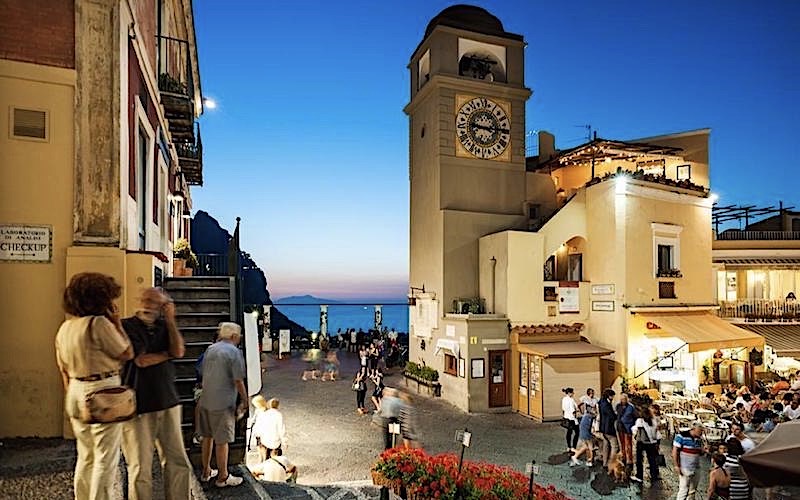
“Reward enough,” Katie repeated.
The
trip to Capri (right) was blissfully
free of the burdens of further
investigation and brain crunching. Katie
had
already phoned her editor and told him in
brief as much as she’d discussed
with David the day before, how she had a great
story that would embarrass the
F.B.I., the I.R.S., and the Federal
Reserve—that was McClure’s kind of
story!—as well as Nazi U-boats, rumrunners,
Mussolini and Italian gangsters.
Who could ask for more?
She told her editor she didn’t think
the time she and David needed to
stay in Naples for the police investigation
would be much longer, and she
promised to begin a first draft of the
article.
After another week she and David filed
papers with the Carabinieri, and
then were able to fly back to New York.
On
the plane David asked, “So, you going back to
that lawyer friend of yours?”
Katie shook her head and said, “Yeah, I
think I’ve been away long enough
for him to miss me like crazy.”
Katie knew David was smitten with her,
and she’d been very careful to
mix her natural ebullience with a measure of
cordial distance. She
could imagine working again with David
someday on another project. They
made a
good team. she thought, and, although she
didn’t know where her relationship
with “the lawyer friend” was going, her
affection for David would have no
effect on it.
*
*
*
*
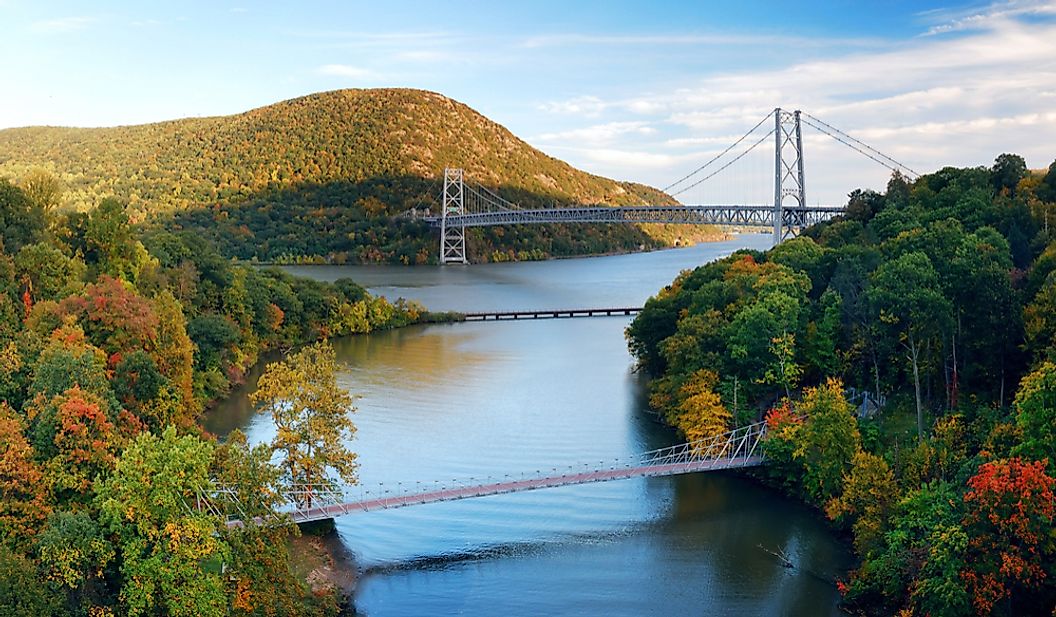
The Hudson River
A
few weeks later, after Katie and David
had worked on piecing the story
together, Katie handed it in to her editor,
who was impressed by the amount of
research and the success it led to.
Although somewhat disappointed by not
knowing the whereabouts of the
last third of the gold—hell, it was a whole
lot more than Gerald Rivera ever
found!—what her editor had was more than
enough for a great story. He
even asked Katie if she’d be interested in
becoming a staff writer for McClure’s.
Katie said she’d think it over after
the article came out, because she
suspected she’d be getting calls from other
magazines and newspapers, maybe
even network TV.
David, meanwhile, was back up the
Hudson tending his garden and ripping
out an overgrowth of hogweed that had taken
hold of a large patch of his land
while he was gone. He
missed Katie and
the adventure they’d had together, hoping
something might develop where she
needed his help again.
 At
that
moment he heard the honk of a small car at the
end of his driveway. He
shielded his eyes and watched Katie Cavuto
getting out of a shiny red Fiat. She
looked very happy.
At
that
moment he heard the honk of a small car at the
end of his driveway. He
shielded his eyes and watched Katie Cavuto
getting out of a shiny red Fiat. She
looked very happy.
“So, what do you think of my new car?
Well, new used car. I didn’t know you
can’t buy a new Fiat in America
now. I
hope they come back.”
“She’s a beauty,” said David, adding to
himself, “So’s the car.”
“I
just thought I’d drive up here, show you my
little car, a-a-n-n-d d . . . give
you the first press copy of McClure’s
with our article in it!”
Katie held it out in front of her and
David grabbed it, then gave her a
hug and kiss on her cheeks.
“Jesus, it really came out. After
all
we went through.”
“Impressive,
eh? And the photos are terrific. They got a
first-rate Italian photographer to
shoot all the locations over there and some
freelancer to shoot Capone’s house
in Miami.”
David flipped through the pages, and,
yes, there were very good shots of
Naples, Angri, the boat dock in Miami, even
the Stella di Mare.”
“And look at this,” said Katie, showing
David a photo of the two of them
together at the trattoria in Positano.
“Where’d they get this?” David asked,
laughing at how good they looked
in it.
“Remember I asked the waiter to take a
picture of us? That’s one of
them. Nick and Nora Charles!”
David couldn’t think of anything to say
except, “I can’t wait to read
it,” then offered her coffee.
“Absolutely,” she said. “You know, for
all the great espresso and
cappuccino we had in Italy, I kind of missed
yours.”
They went back to the house and David
made the coffee, then they spread
the magazine out on the table—Katie had
brought three copies for him—and they
pored through it like high school kids with a
yearbook.
After a couple of hours of reminiscing
about events that seemed to have
taken place years ago and so far away, Katie
said, “Well, I’ve got to get
going. Rev up the old Fiat.”
David couldn’t bring himself to ask
Katie if she was seeing the “lawyer
guy” that evening.
After a long embrace on David’s lawn,
Katie said, “You’re a good cop,
David Greco.”
“That all?”
“You’re a good man, too.”
“Anything else?”
Katie grinned. “And you’re going to
make some woman a great husband.”
David gave her a goodbye hug, and then
she walked back to her car.
David waved and called out, “Take care,
Katie.”
Then he watched
her drive away until he couldn’t see her
anymore.
© John Mariani, 2015
❖❖❖
CUVÉE PALOMAR IS A WINE MADE BASED
ON ENDURING CLIMATE CHANGE
By John Mariani
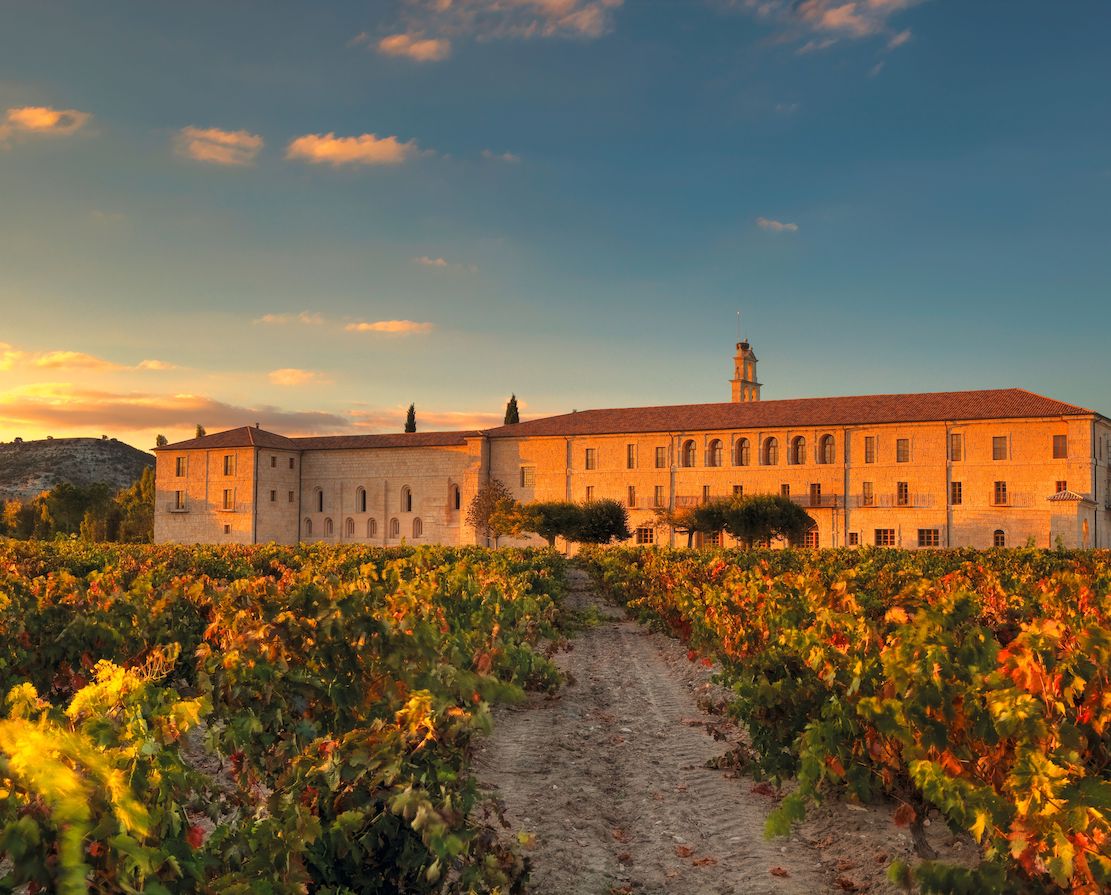
ABADIA RETUERTA
In 1986 the European
Union classified Spain’s wine regions into 17
autonomous appellations approved by the
Instituto Nacional de Denominaciones de
Origin, and in particular the reputation of
the wines of the Ribera del Duero
region, now with more than 300 wineries under
that appellation. This created something
of
a problem for the highly regarded estate of
Abadia Retuerta, whose winery was founded in
1996, whose 500 acres planted as vineyards lie
outside the official Ribera del Duero
appellation (within which the esteemed Vega
Sicilia estate lies just five miles away).
Winemaker/enologist Ángel
Anocibar (below) therefore decided to make
a mark of its distinction by developing :its
own Pago (terroir) to produce one
of Spain’s most prestigious wines. Its location
also allowed it to use grape varietals not
approved within the Ribera appellation. “Time has
demonstrated we were right,” says General Manager
Enrique Valero. In 2005
its Selección Especial 2001 won the International
Wine Challenge in London as “the world’s best red
wine.”
This year Abadia Retuerta has released its
Cuvée Palomar from the 2017 vintage, and I thought
it time for Anocibar to explain the new blend and
to assess the current global status of the Spanish
wine market.
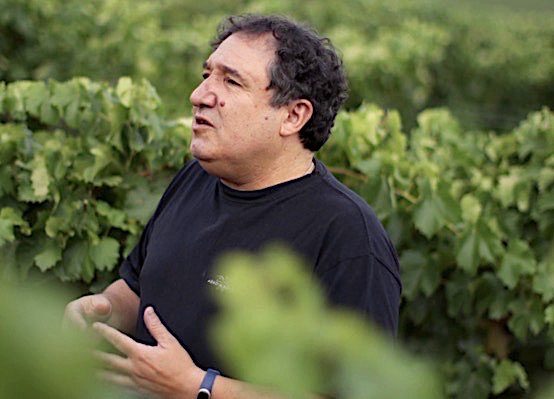
Tell me about what was intended
by creating Cuvée Palomar. And how
it differs from what the estate has been making
for 30 years.
When you hear about our whole trajectory, it
will become clear that the newly created Cuvée
Palomar is the wine that brings together all our
studies from over the years. With the new climatic
conditions we are experiencing, the behavior of our
Tempranillo, our identity, our native variety, has
changed, and we felt it needed some help.
The composition of this new Cuvée Palomar is
based on the Tempranillo and its assemblage is
rounded off with Garnacha, Malbec and Graciano to
give it more aromatic complexity and a more balanced
flavor. The addition of these varieties helps and
balances the Tempranillos of this new era.
Furthermore, the wine is aged for slightly longer in
oak barrels to complete its refinement and hone its
complexity.
In the coming years we will have to keep an
eye on climate change and whether it is getting even
worse, as seems to be the case. We will continue to
study the changes, in order to apply them to
vineyard management. In many areas of Spain and
elsewhere, new varieties are being authorized to
mitigate these changes, while still maintaining the
signature style of each area. This new
Cuvée brings along the spirit and the style of the
old one, with purity, finesse and elegance. A
totally different wine in style than, say, our
Selección Especial.
When did you come to the estate
and what were you challenged to do? Give me some
of your background.
I joined the revived Abadía Retuerta project
in 1996. Previously, I had studied in Bordeaux,
where I completed my doctoral thesis. After two
years of working in the area, Pascal Delbeck (the
wine consultant for Abadía Retuerta and former
winemaker of Château Ausone and Château Belair)
recruited me for this project. The first task we did
was to identify the different vineyard plots
according to the variety planted, the type of soil,
exposure, altitude. We identified 54 different
plots, some of which are located around the
monastery and the majority on the hillside. The
winery was designed according to Pascal’s criteria,
so that all of these plots could be worked on
individually, with the utmost respect for the grapes
themselves. They are naturally processed by gravity,
without any pumping at all, as in the times of the
old monks of the monastery.
How does the soil differ from
Ribera del Duero?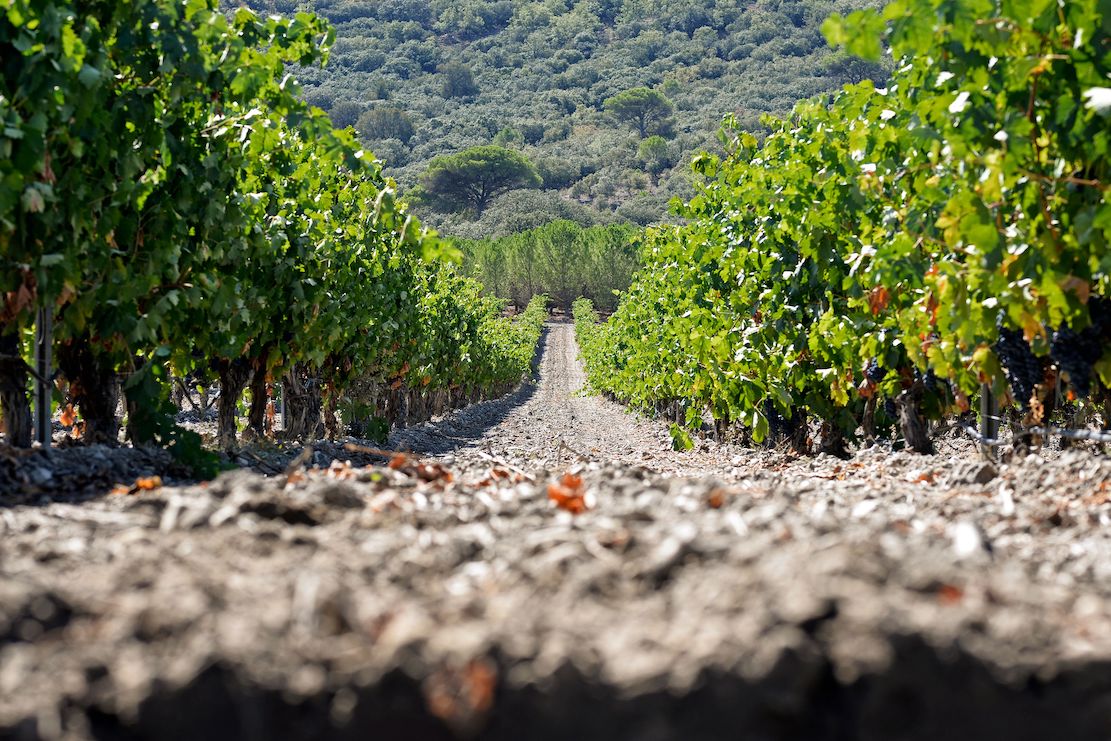
The autonomous community of Castilla y León
covers a vast area in the north of Spain. It is made
up of a high-altitude plateau (the northern part of
the “meseta
castellana”) with mountains to the north, east
and south, and Portugal to the west. Ribera del
Duero DO lies in the upper valley of the River
Duero, and Abadía Retuerta is located right next to
its western end.
The bedrock in the area is basically
limestone, with a sandy clay sub-layer and then a
topsoil of stones (though in some areas the topsoil
is sand). This tends to be free draining and low in
organic matter, reducing the vigor of the vines.
However, this changes a lot whether the vineyards
are located in the fertile valleys close to the
Duero River, on the slopes where soils are poorer,
or up in the moorland, where you can find the
shallowest soils with mother rock closer to the
surface.
The soils
at Abadía Retuerta have certain features that
differentiate them from most of those found in the
Ribera del Duero. This is one of the reasons why
Abadía Retuerta’s wine is about to be recognized as
“vino de pago,”
the
maximum recognition of quality of the Spanish wines.
Soils at Abadía Retuerta have a greater
proportion of sand and gravel in the lower parts of
the estate, with some proportion of clay. The water
tables, due to the proximity to the river, ensure
enough water supply as the roots have gone that deep
in search of nutrients. There are some plots, or pagos, with
even more than 90% of sand where surviving is almost
a battle for the vines, producing radical wines with
a lot of character. Lastly, in the mid and upper
slopes, where 80% of the vines of Abadía Retuerta
are planted, we find limestone sub-soils with sand
and stones on the surface, the fine texture of these
soils provide a good water retention throughout the
entire cycle.
 How
has
climate change affected Spain generally and Abadía
Retuerta specifically?
How
has
climate change affected Spain generally and Abadía
Retuerta specifically?
This phenomenon is not new in the history of
Abadía Retuerta. Between 1850 and 1950, the planet
went through the “Little Ice Age,” a tremendously
cold period that greatly changed the wines being
produced. From then onwards, old texts only mention
data on the production of red wines, as opposed to
white wines. This cold period probably forced the
inhabitants to look for a grape variety that ripened
earlier, which is why we believe that this was the
origin of the Tempranillo (Tempranillo,
meaning “early”) in the region.
Since our arrival in 1996, we have carried
out a climate study from the 1960s to the present
day. Since that time, the average temperature has
risen 1.4ºC, which is bringing the harvest date
forward considerably. Nevertheless, the important
thing observed is that despite the tendency, each
year is different, and our studies and experience of
25 vintages allow us to know/understand each vintage
well and what would be the best way to manage it,
comparing to similar ones and adding all that we
have learned over the years. Rainfall has also
changed over time, which has led us to study the
real water reserves of the different plots. To that
end, we have installed humidity sensors in the
estate’s different soils.
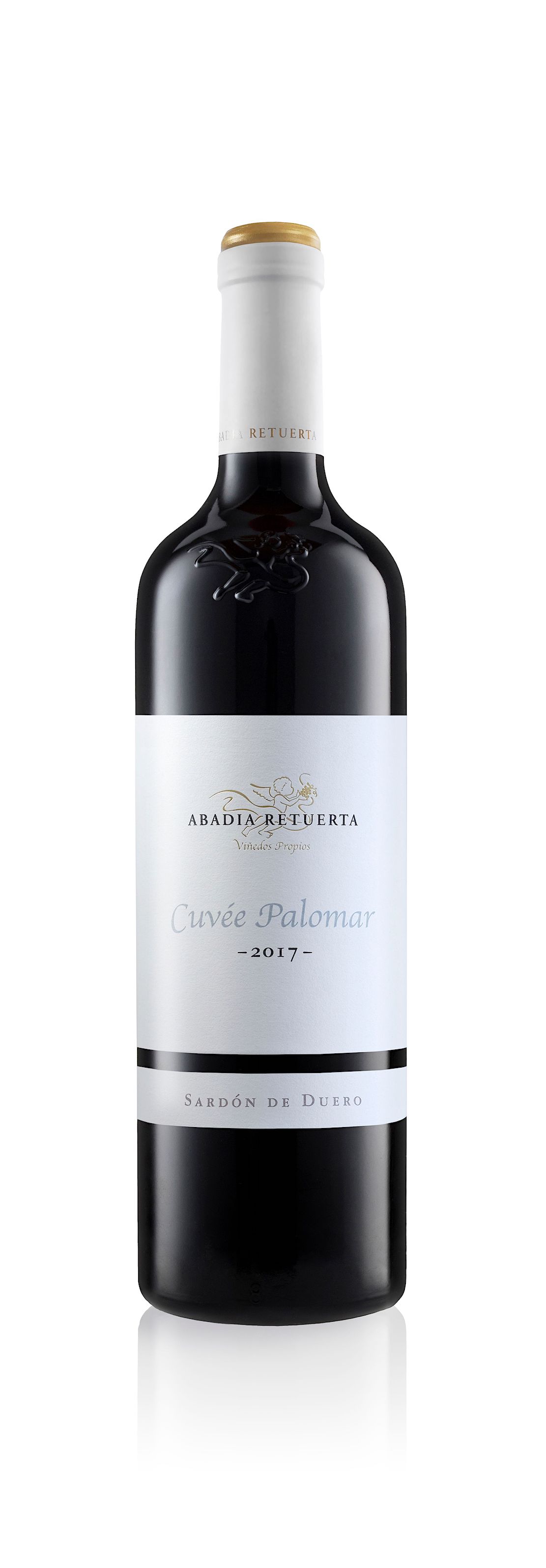 How do you maintain sustainability?
How do you maintain sustainability?
All our studies and experience to date allow
us to save energy and water. We use organic
practices throughout the vineyard, but we go even
further: our knowledge of vine diseases means that
we only intervene if the risk to the plants is high,
thus minimizing the number of treatments. This
criterion is also applied in the winery, where more
than a third of the energy consumed comes from our
solar panels, with more than 500 installed on the
winery roof.
Since
1996, we have carried out numerous ecological
actions in order to favor bio-diversity and create
naturally balanced habitats for the flora and fauna.
More than 65,000 pine trees have been planted, and
we drew up a forest management plan and obtained the
PEFC certification. We fight against the
processionary disease through the installation of
nest boxes to encourage the breeding of birds,
instead of using insecticides.
The wasted water from the winery is taken to
artificial lagoons, then depurated so we can use it
back again for irrigation. We have also built small
concrete ponds we periodically fill with water for
the animals in the hottest months, and we have
perceived a major increase of many different species
thus the increase of natural balanced bio-diversity
in the estate.
We are also working with FIRE (International
Foundation for the Restoration of Ecosystems) on
different programs and took part in the Haprowine
project, carrying out an energy audit that has
enabled us to detect the points where we can reduce
our energy consumption and therefore our CO2
emissions.
We are as well recovering a Historic
Pre-phylloxera vineyard, which we found accidentally
in a forest area where the monks used to grow vines
in the 19th century, prior to phylloxera, so we have
an ancient clone of Tempranillo that has survived
the harsh conditions of our terroir. We have also
developed in 2019 our own vegetable garden that
provide our restaurants with fresh produce, as did
the monks.
Last but not least, Abadía Retuerta also has
created the Terroir Academy, a training program
focused on sommeliers, to disseminate knowledge
about viticulture, climate and grape varieties, not
only applicable to our area but also around the
world.
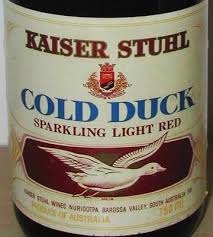 AFTER FOUR HOURS' RESTING IT
AFTER FOUR HOURS' RESTING IT GOES WELL WITH A BOTTLE OF COLD DUCK
From “This Whole Duck
Recipe Is Perfectly Imperfect” By Melissa Clark, NY
Times (Dec. 15, 2021).
- YIELD 4 servings
- TIME 2 1/2 hours,
plus at least 4 hours’ resting
❖❖❖
Any of John Mariani's books below may be ordered from amazon.com.
 The Hound in Heaven
(21st Century Lion Books) is a novella, and
for anyone who loves dogs, Christmas, romance,
inspiration, even the supernatural, I hope you'll find
this to be a treasured favorite. The story
concerns how, after a New England teacher, his wife and
their two daughters adopt a stray puppy found in their
barn in northern Maine, their lives seem full of promise.
But when tragedy strikes, their wonderful dog Lazarus and
the spirit of Christmas are the only things that may bring
his master back from the edge of despair.
The Hound in Heaven
(21st Century Lion Books) is a novella, and
for anyone who loves dogs, Christmas, romance,
inspiration, even the supernatural, I hope you'll find
this to be a treasured favorite. The story
concerns how, after a New England teacher, his wife and
their two daughters adopt a stray puppy found in their
barn in northern Maine, their lives seem full of promise.
But when tragedy strikes, their wonderful dog Lazarus and
the spirit of Christmas are the only things that may bring
his master back from the edge of despair. WATCH THE VIDEO!
“What a huge surprise turn this story took! I was completely stunned! I truly enjoyed this book and its message.” – Actress Ali MacGraw
“He had me at Page One. The amount of heart, human insight, soul searching, and deft literary strength that John Mariani pours into this airtight novella is vertigo-inducing. Perhaps ‘wow’ would be the best comment.” – James Dalessandro, author of Bohemian Heart and 1906.
“John Mariani’s Hound in Heaven starts with a well-painted portrayal of an American family, along with the requisite dog. A surprise event flips the action of the novel and captures us for a voyage leading to a hopeful and heart-warming message. A page turning, one sitting read, it’s the perfect antidote for the winter and promotion of holiday celebration.” – Ann Pearlman, author of The Christmas Cookie Club and A Gift for my Sister.
“John Mariani’s concise, achingly beautiful novella pulls a literary rabbit out of a hat – a mash-up of the cosmic and the intimate, the tragic and the heart-warming – a Christmas tale for all ages, and all faiths. Read it to your children, read it to yourself… but read it. Early and often. Highly recommended.” – Jay Bonansinga, New York Times bestselling author of Pinkerton’s War, The Sinking of The Eastland, and The Walking Dead: The Road To Woodbury.
“Amazing things happen when you open your heart to an animal. The Hound in Heaven delivers a powerful story of healing that is forged in the spiritual relationship between a man and his best friend. The book brings a message of hope that can enrich our images of family, love, and loss.” – Dr. Barbara Royal, author of The Royal Treatment.
 |
The Encyclopedia of American Food and Drink by John F. Mariani (Bloomsbury USA, $35) Modesty forbids me to praise my own new book, but let me proudly say that it is an extensive revision of the 4th edition that appeared more than a decade ago, before locavores, molecular cuisine, modernist cuisine, the Food Network and so much more, now included. Word origins have been completely updated, as have per capita consumption and production stats. Most important, for the first time since publication in the 1980s, the book includes more than 100 biographies of Americans who have changed the way we cook, eat and drink -- from Fannie Farmer and Julia Child to Robert Mondavi and Thomas Keller. "This book is amazing! It has entries for everything from `abalone' to `zwieback,' plus more than 500 recipes for classic American dishes and drinks."--Devra First, The Boston Globe. "Much needed in any kitchen library."--Bon Appetit. |
"Eating Italian will never be the same after reading John Mariani's entertaining and savory gastronomical history of the cuisine of Italy and how it won over appetites worldwide. . . . This book is such a tasteful narrative that it will literally make you hungry for Italian food and arouse your appetite for gastronomical history."--Don Oldenburg, USA Today. "Italian
restaurants--some good, some glitzy--far
outnumber their French rivals. Many of
these establishments are zestfully described
in How Italian Food Conquered the World, an
entertaining and fact-filled chronicle by
food-and-wine correspondent John F.
Mariani."--Aram Bakshian Jr., Wall Street
Journal.
"Equal parts
history, sociology, gastronomy, and just
plain fun, How Italian Food Conquered the
World tells the captivating and delicious
story of the (let's face it) everybody's
favorite cuisine with clarity, verve and
more than one surprise."--Colman Andrews,
editorial director of The Daily
Meal.com. "A fantastic and fascinating
read, covering everything from the influence
of Venice's spice trade to the impact of
Italian immigrants in America and the
evolution of alta cucina. This book will
serve as a terrific resource to anyone
interested in the real story of Italian
food."--Mary Ann Esposito, host of PBS-TV's
Ciao
Italia. "John Mariani has written the
definitive history of how Italians won their
way into our hearts, minds, and
stomachs. It's a story of pleasure over
pomp and taste over technique."--Danny Meyer,
owner of NYC restaurants Union Square
Cafe, The Modern, and Maialino.
|
 |
 |
 |
 |
 |
 |
 Everett Potter's Travel Report:
Everett Potter's Travel Report: 
 Eating Las
Vegas JOHN CURTAS has been covering
the Las Vegas food and restaurant scene
since 1995. He is the co-author of EATING LAS
VEGAS – The 50 Essential Restaurants (as
well as the author of the Eating Las
Vegas web site: www.eatinglasvegas.
He can also be seen every Friday morning as
the “resident foodie” for Wake Up With the
Wagners on KSNV TV (NBC) Channel 3 in
Las Vegas.
Eating Las
Vegas JOHN CURTAS has been covering
the Las Vegas food and restaurant scene
since 1995. He is the co-author of EATING LAS
VEGAS – The 50 Essential Restaurants (as
well as the author of the Eating Las
Vegas web site: www.eatinglasvegas.
He can also be seen every Friday morning as
the “resident foodie” for Wake Up With the
Wagners on KSNV TV (NBC) Channel 3 in
Las Vegas.
MARIANI'S VIRTUAL GOURMET
NEWSLETTER is published weekly. Publisher: John Mariani. Editor: Walter Bagley. Contributing Writers: Christopher
Mariani, Misha Mariani, John A. Curtas, Gerry Dawes, Geoff Kalish.
Contributing
Photographer: Galina Dargery. Technical
Advisor: Gerry
McLoughlin.
If you wish to subscribe to this
newsletter, please click here: http://www.johnmariani.com/subscribe/index.html
© copyright John Mariani 2021
